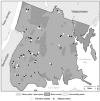Urban farmers' markets: accessibility, offerings, and produce variety, quality, and price compared to nearby stores
- PMID: 25733377
- PMCID: PMC4410073
- DOI: 10.1016/j.appet.2015.02.034
Urban farmers' markets: accessibility, offerings, and produce variety, quality, and price compared to nearby stores
Abstract
Most food-environment research has focused narrowly on select stores and restaurants. There has been comparatively less attention to non-storefront food sources like farmers' markets (FMs), particularly in urban communities. The objective of the present study was to assess FMs' potential contribution to an urban food environment in terms of specific foods offered, and compare FM accessibility as well as produce variety, quality, and price to that of nearby stores. Investigators conducted a detailed cross-sectional assessment of all FMs in Bronx County, NY, and of the nearest store(s) selling produce within a half-mile walking distance (up to two stores per FM). The study included 26 FMs and 44 stores. Investigators assessed accessibility (locations of FMs and stores relative to each other, and hours of operation for each), variety (the number and type of all food items offered at FMs and all fresh produce items offered at stores), quality (where produce items were grown and if they were organic), and price (including any sales prices or promotional discounts). Analyses included frequencies, proportions, and variable distributions, as well as mixed-effect regressions, paired t-tests, and signed rank tests to compare FMs to stores. Geographic information systems (GIS) allowed for mapping of FM and store locations and determining street-network distances between them. The mean distance between FMs and the nearest store selling fresh produce was 0.15 miles (range 0.02-0.36 miles). FMs were open substantially fewer months, days, and hours than stores. FMs offered 26.4 fewer fresh produce items on average than stores (p values <0.02). FM produce items were more frequently local and organic, but often tended toward less-common/more-exotic and heirloom varieties. FMs were more expensive on average (p values <0.001 for pairwise comparisons to stores) - even for more-commonplace and "conventional" produce - especially when discounts or sales prices were considered. Fully, 32.8% of what FMs offered was not fresh produce at all but refined or processed products (e.g., jams, pies, cakes, cookies, donuts, juice drinks). FMs may offer many items not optimal for good nutrition and health, and carry less-varied, less-common fresh produce in neighborhoods that already have access to stores with cheaper prices and overwhelmingly more hours of operation.
Keywords: Farmers' markets; Food environment; Food stores; Fruit; Processed foods; Vegetables.
Copyright © 2015 Elsevier Ltd. All rights reserved.
Conflict of interest statement
Figures




Similar articles
-
Unexpected Neighborhood Sources of Food and Drink: Implications for Research and Community Health.Am J Prev Med. 2018 Aug;55(2):e29-e38. doi: 10.1016/j.amepre.2018.04.011. Epub 2018 Jun 12. Am J Prev Med. 2018. PMID: 29907454 Free PMC article.
-
Comparing the availability, price, variety and quality of fruits and vegetables across retail outlets and by area-level socio-economic position.Public Health Nutr. 2013 Jan;16(1):171-8. doi: 10.1017/S1368980012000766. Epub 2012 Mar 20. Public Health Nutr. 2013. PMID: 22433912 Free PMC article.
-
Farmers' markets and the local food environment: identifying perceived accessibility barriers for SNAP consumers receiving temporary assistance for needy families (TANF) in an urban Oklahoma community.J Nutr Educ Behav. 2015 Mar-Apr;47(2):127-33.e1. doi: 10.1016/j.jneb.2014.12.008. J Nutr Educ Behav. 2015. PMID: 25754298 Free PMC article.
-
Review of the nutritional implications of farmers' markets and community gardens: a call for evaluation and research efforts.J Am Diet Assoc. 2010 Mar;110(3):399-408. doi: 10.1016/j.jada.2009.11.023. J Am Diet Assoc. 2010. PMID: 20184990 Review.
-
An Examination of Failed Grocery Store Interventions in Former Food Deserts.Health Educ Behav. 2019 Oct;46(5):749-754. doi: 10.1177/1090198119853009. Epub 2019 Jun 19. Health Educ Behav. 2019. PMID: 31216883 Review.
Cited by
-
Unexpected Neighborhood Sources of Food and Drink: Implications for Research and Community Health.Am J Prev Med. 2018 Aug;55(2):e29-e38. doi: 10.1016/j.amepre.2018.04.011. Epub 2018 Jun 12. Am J Prev Med. 2018. PMID: 29907454 Free PMC article.
-
When food isn't medicine - A challenge for physicians and health systems.Prev Med Rep. 2018 Feb 16;10:62-65. doi: 10.1016/j.pmedr.2018.02.007. eCollection 2018 Jun. Prev Med Rep. 2018. PMID: 30023160 Free PMC article.
-
Unreliable and Difficult-to-Access Food for Those in Need: A Qualitative and Quantitative Study of Urban Food Pantries.J Community Health. 2019 Feb;44(1):16-31. doi: 10.1007/s10900-018-0549-2. J Community Health. 2019. PMID: 30019196 Free PMC article.
-
Land suitability analysis of urban agriculture for different investment scenarios: Evidence from fuzhou of China.Heliyon. 2023 Oct 10;9(10):e20817. doi: 10.1016/j.heliyon.2023.e20817. eCollection 2023 Oct. Heliyon. 2023. PMID: 37867889 Free PMC article.
-
Impact of a farmers' market nutrition coupon programme on diet quality and psychosocial well-being among low-income adults: protocol for a randomised controlled trial and a longitudinal qualitative investigation.BMJ Open. 2020 May 5;10(5):e035143. doi: 10.1136/bmjopen-2019-035143. BMJ Open. 2020. PMID: 32371514 Free PMC article.
References
-
- Bader MD, Purciel M, Yousefzadeh P, Neckerman KM. Disparities in Neighborhood Food Environments: Implications of Measurement Strategies. Econ Geogr. 2010;86:409–430. - PubMed
Publication types
MeSH terms
Grants and funding
LinkOut - more resources
Full Text Sources
Other Literature Sources
Miscellaneous

